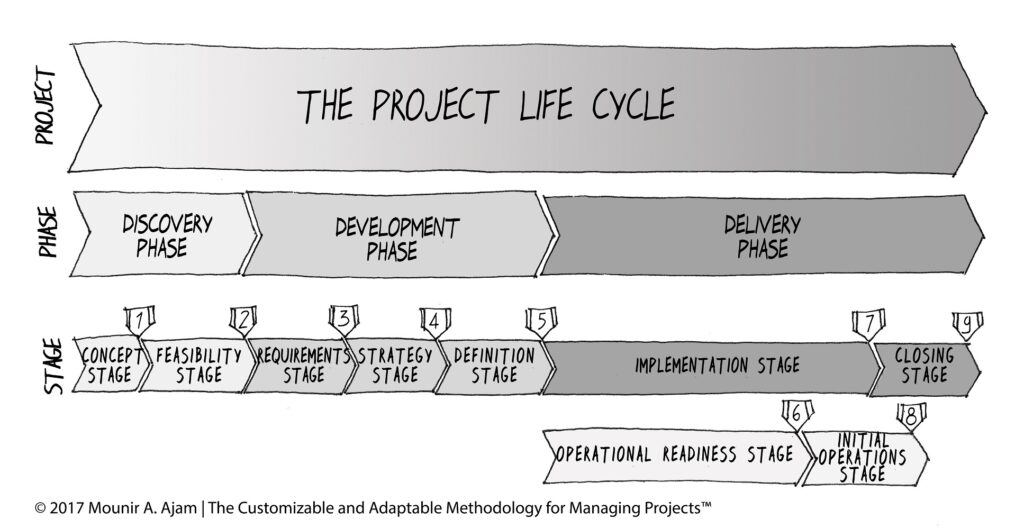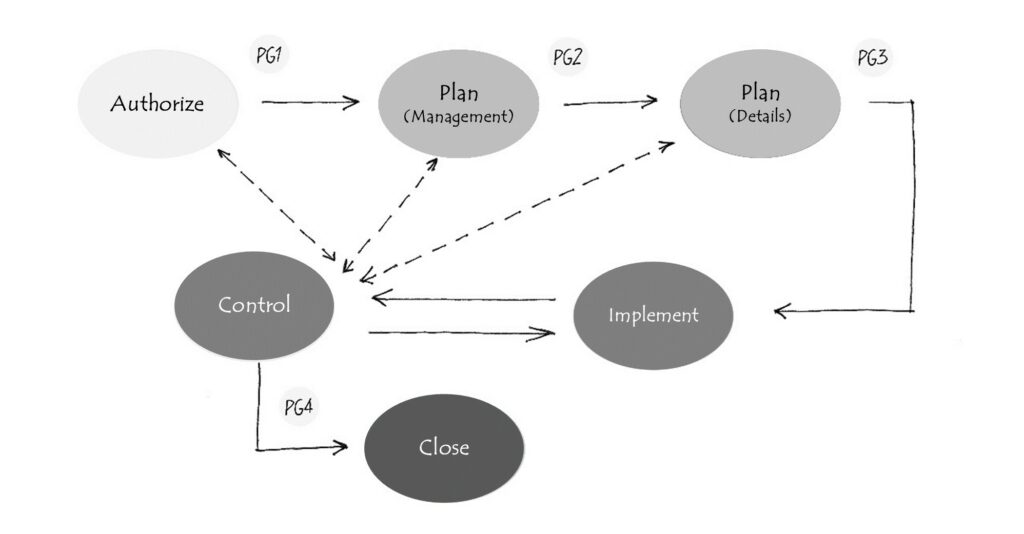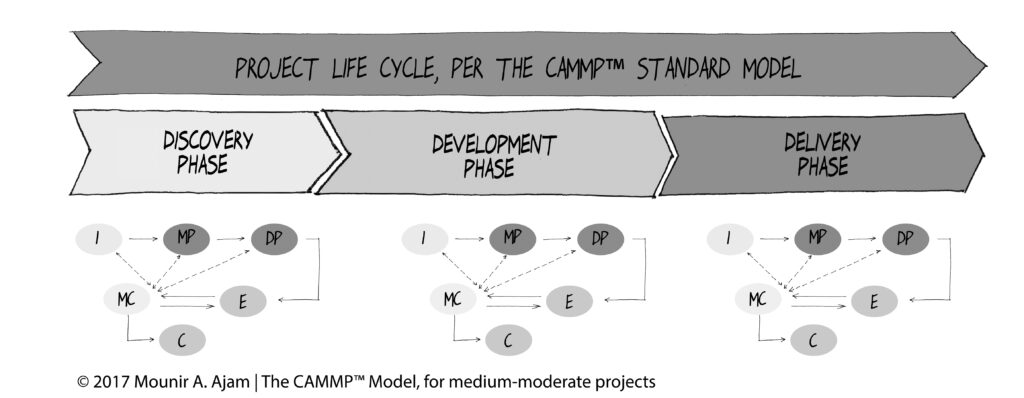The text in this blog post is from a seven-volume e-book series that we are working on. It is Chapter 7 from Volume 2.
Introduction
The Customizable and Adaptable Methodology for Managing Projects™ is a three-dimensional methodological approach. In other words, to manage projects effectively and at
What are these three dimensions?
The First Dimension
The first dimension is the project life cycle (the horizontal dimension), which helps practitioners follow a project from idea to closure (and beyond). Figure 5 (the first figure) is repeated from an earlier chapter, and it presents the first dimension. Keep in mind, this image represents the standard model without any customization, adaptation, or other tailoring steps.

The project life cycle consists of phases, stages, stage deliverables, and stage gates. What CAMMP™ offers is a standard model that can be tailored; tailoring is covered in more details in Volume 6 of this series.
The intent of assigning “the first dimension” to the project life cycle is to emphasize that a project life cycle is the most basic form of a methodology and must be the starting point. In other words, whether we are dealing with a micro project or a mega project, organizations should follow a project life cycle, or what is also known as a stage-gate process. The project life cycles will vary from one industry to another or project type. Hence the need to start with a standard model, then customize to an industry and organization, adapt to an organizational function, and modify to fit a given project class accounting for size and complexity. The ultimate purpose is to start with a standardized methodological approach to develop tailored methods that are fit for purpose[i].
Volume 3 will provide a detailed explanation of every stage, and its components.
The Second Dimension
The first dimension can be good enough to manage micro or basic projects without the use of the second dimension. It helps organizations manage a project C2C, concept to closure. Therefore, this dimension is a must for all projects regardless of type, domain, size or complexity. However, once again we must emphasize that as project grow in size or complexity, there is a need for the second dimension.
The second dimension is the vertical dimension of the project life cycle. It is about the application of the project management processes along the project life cycle in every stage or phase. In other words, the PLC help us manage C2C but to manage each phase or stage, we need the second dimension.
Before we show the big picture, let us emphasize a vital point. For the effective management of every phase of the project, we need a set of processes. PMI and ISO offer us the concept of process groups, which we modified and expanded it for the CAMMP™ methodological approach. Figure 6 (this second image) presents the set of processes to manage a stage or a phase, as modified by SUKAD.

Now, it is time to integrate the first two dimensions, which is the focus of Figure 7 (this third image).

What this image shows, is that in every phase, these set of processes repeat. Keep in mind that CAMMP™ use the term process to represent a set of process steps that are necessary to accomplish a process deliverable, such as a stage authorization document or a stage management plan[ii].
Volume 4 will provide more coverage of the second dimension.
The Third Dimension
A quick refresher first.
- We stated that the first dimension can be used on its own (without the second dimension) for basic or small projects.
- We also stated that as project grow in size, complexity, or number of resources and people required, we need the second dimension.
- Integrating the two dimensions, the PLC help the project management team manage the project concept to closure, across the stages, whereas the processes help the PMT in managing each phase (or stage) of the project.
Wonderful, then what is the third dimension for?
The essential view of the third dimension
Unfortunately, we do not have a graphical representation for this since it is not like the first two dimensions; not a specific step or a stage or a process. The third dimension consists of layers, layers that organizations could implement along (and on top of) the project life cycle and the processes. These layers are what help organizations move from a fundamental methodological approach and transform it into a highly sophisticated and robust system that will enable and empower them to seek excellence.
In other words, whether you are managing a small or a mega project, a technology or a marketing project, in for-profit or not-for-profit organization, we need to apply some, if not all of the topics of the third dimension. This would be necessary, if organizations and teams want to elevate their projects and organizational performance to outstanding levels.
More on the third dimension
Organizations must ensure the competence of those working on projects. The competence would have to be appropriate to the type, domain, or class of the project. Competence is one of the advanced topics of the third dimension.
Along with competence, organizations cannot elevate performance without assessing the success of the projects they complete. We do have a project success model that we incorporate with CAMMP™ but it can also be used for other methodological approaches.
In addition to competence and project success, we address sustainability and best practices as the other two advanced topics to help organizations reach higher level of project management maturity.
Volume 4 will provide more
coverage of the third dimension and its advanced topics.
[i] Volume 6 of this series will provide more details about tailoring the steps for developing tailored methods. In the meantime, this video playlist is a good starting point: https://www.youtube.com/playlist?list=PLiXup1lJ-_TNEkPCJXBy9eKUBJV8FmlDS.
[ii] The image shown is the SUKAD model for medium-moderate complexity projects.

Hey there! Do you use Twitter? I’d like to follow you if
that would be ok. I’m undoubtedly enjoying your blog and look forward to new posts.
Hey! I realize this is somewhat off-topic however I needed to ask.
Does building a well-established blog such as yours take a large amount of work?
I’m completely new to operating a blog but I do write in my journal on a
daily basis. I’d like to start a blog so I can easily share my personal experience and feelings online.
Please let me know if you have any suggestions or tips for new aspiring bloggers.
Appreciate it!
Hi it’s me, I am also visiting this website daily, this web page is in fact
fastidious and the viewers are in fact sharing fastidious thoughts.
It’s really very complicated in this active life to listen news on TV, so I just use the web for that
purpose, and obtain the newest news.
You ought to be a part of a contest for one of the greatest
websites online. I am going to recommend this web site!
Pretty component to content. I just stumbled upon your blog and in accession capital to assert
that I acquire in fact loved account your weblog posts.
Any way I’ll be subscribing on your augment and even I fulfillment you
get entry to consistently fast.
Remarkable! Its in fact awesome piece of writing, I have got much clear idea concerning from this article.